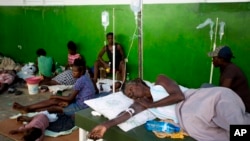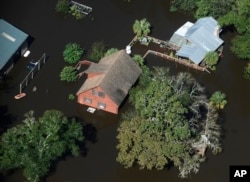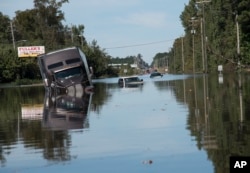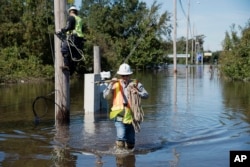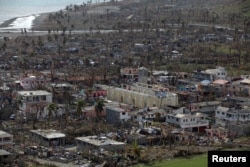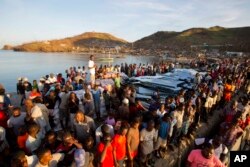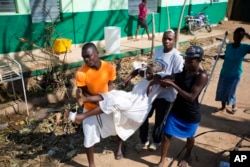Flooding from Hurricane Matthew remained a threat Tuesday in parts of the eastern United States, while the death toll continues to grow in the Caribbean.
Haiti, the country hardest hit, observed the last of its three official days of mourning Tuesday. Official death tolls there have varied widely, from around 400 to over 1,000. Many areas of the country remained difficult to reach.
By Tuesday morning, the U.S. death toll stood at 27. Hundreds of thousands remain without power, and the situation could worsen as rivers crest.
In North Carolina, helicopters and rescue boats carried people to safety after a levee was breached near the town of Lumberton, according to Governor Pat McCrory.
Fifteen of the 27 deaths occurred in North Carolina - all but one of them in that state involving motor vehicles.
"Do not go through water," McCrory urged North Carolina drivers at a news conference Tuesday morning. "We've had over 10 people killed as a result of that. We're not messing around and we do not want to put people at risk to save you once you make that decision."
Dozens of river and stream gauges were still showing flood stage across the Carolinas and Virginia, and five locations in North Carolina were at all-time highs, according to the National Weather Service.
State of emergency
After speaking with FEMA Administrator Craig Fugate and Homeland Security adviser Lisa Monaco, President Barack Obama declared a state of emergency in North Carolina on Monday. The declaration will make federal funding available to affected individuals in 10 counties hit by the storm.
Matthew, which dissipated after leaving the Atlantic coast, was the most powerful storm to hit the eastern United States in nearly a decade, and one of the longest-lasting major hurricanes on record.
Damage estimates in the U.S. are in the billions of dollars.
But the destruction was on another level in Haiti, where thousands of homes were flattened, crops destroyed and critical infrastructure left in tatters.
A United Nations official in Haiti, surveying the vast destruction, ruined crops and casualties, described the scene as if a nuclear bomb had gone off.
Paul Hasse, national director for the humanitarian agency World Vision in Port-au-Prince, told VOA virtually nothing in Haiti’s southwest was spared.
"The island in the middle on the western side took a really hard blow. Fifty percent of the houses are destroyed there. And the northwest as well. It's not getting a lot of attention, but we're hearing from our partners who worked there that it's extremely hard hit," he said.
Long term problems
The immediate concern is keeping people alive and treating cholera cases, Hasse said. But that will eventually give way to longer-term problems, such as how to restore crops and rebuild homes.
The United Nations on Monday appealed for $119 million to bring life-saving assistance to Haiti.
"Hurricane Matthew has resulted in the largest humanitarian crisis in Haiti since the 2010 earthquake at a time when the country is already facing an increase in the number of cholera cases, and severe food insecurity and malnutrition," the U.N. appeal said.
Haiti says 1.5 million people have been affected by the hurricane and 350,000 are in need of immediate assistance as most are homeless.
The U.S. military has been delivering food and medicine to Haiti by air and sea, as well as heavy-lift helicopters, bulldozers, water-delivery vehicles and mobile operating rooms.
UNICEF says the conditions in Haiti are "perfect breeding grounds for waterborne diseases." Marc Vincent, UNICEF's representative in Haiti says, "Every day that goes by increases the threat of cholera."
The catastrophic damage was made worse because the impoverished country is still recovering from a devastating earthquake in 2010. Thousands of people who have been living in flimsy shelters since the earthquake saw those washed away by the hurricane, which also destroyed a bridge that is the only link between a large portion of southern Haiti and the rest of the country.
Officials have warned the list of casualties will likely climb, perhaps significantly, as rescuers manage to reach remote villages.
Video images from Haiti showed entire landscapes of metal shanties that lost their roofs in the winds and driving rains, along with downed trees and fields of mud from overflowing rivers.
The International Red Cross has also issued an emergency appeal for $6.9 billion in relief aid for Haiti, the poorest country in the Western Hemisphere.




